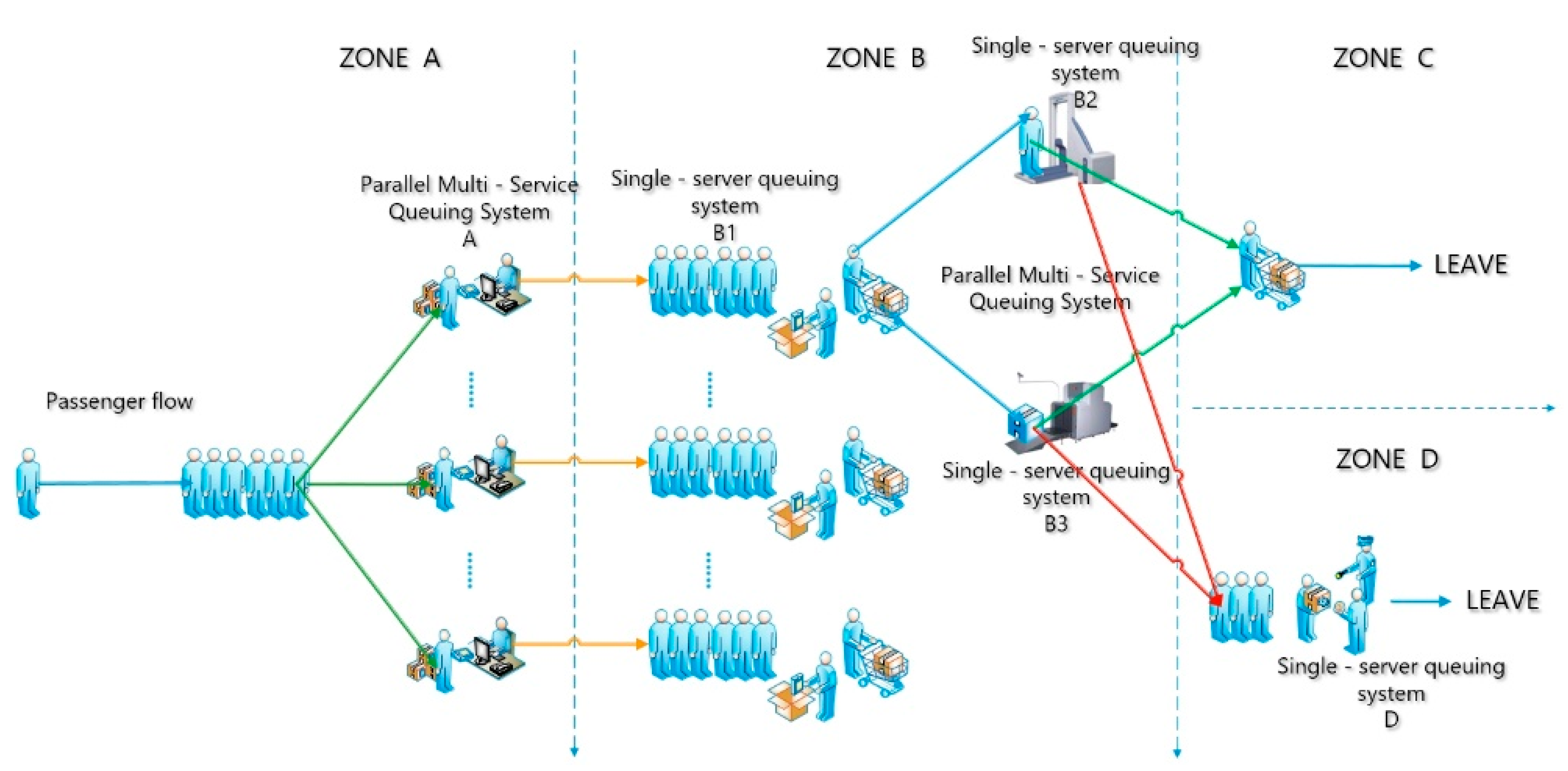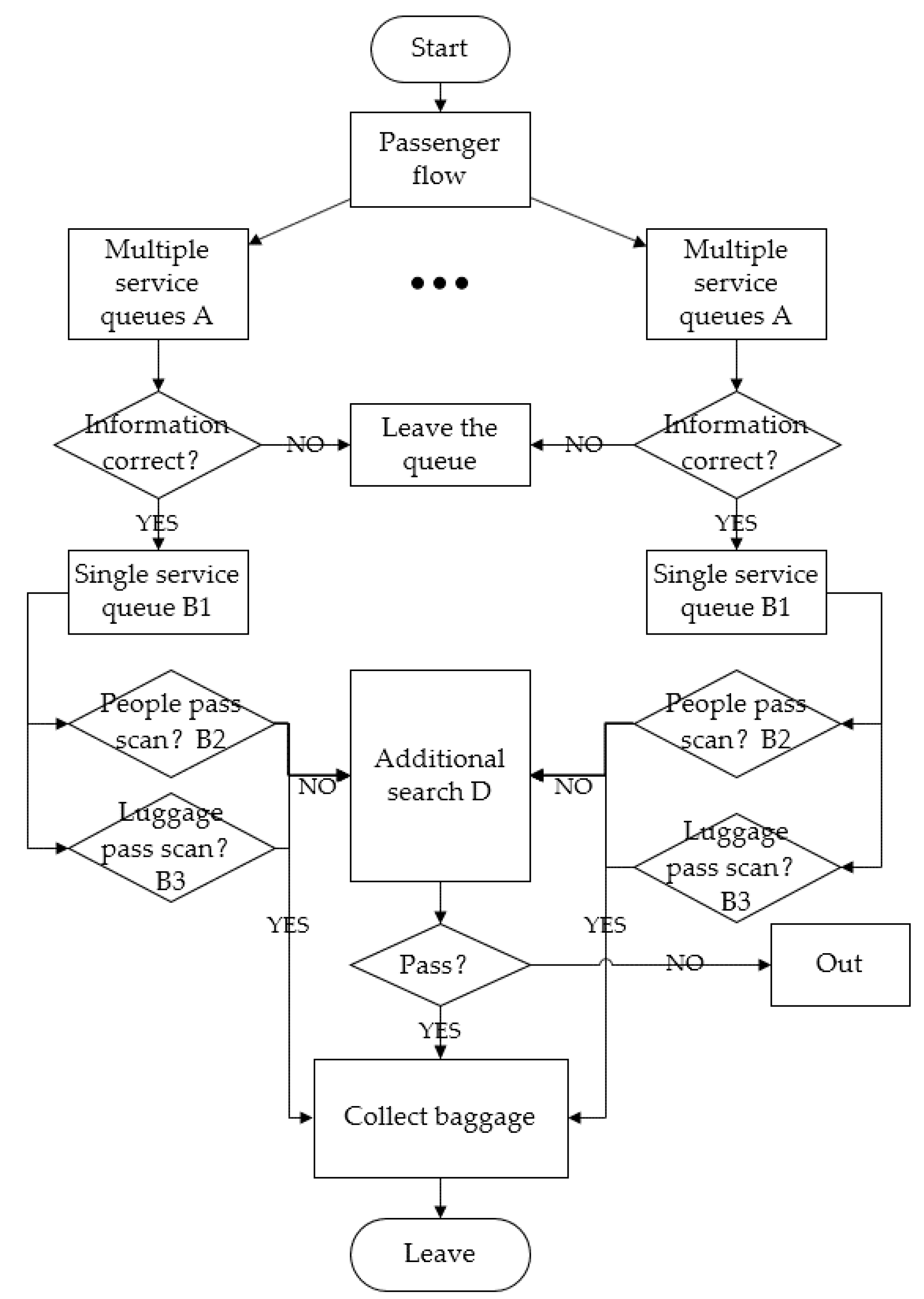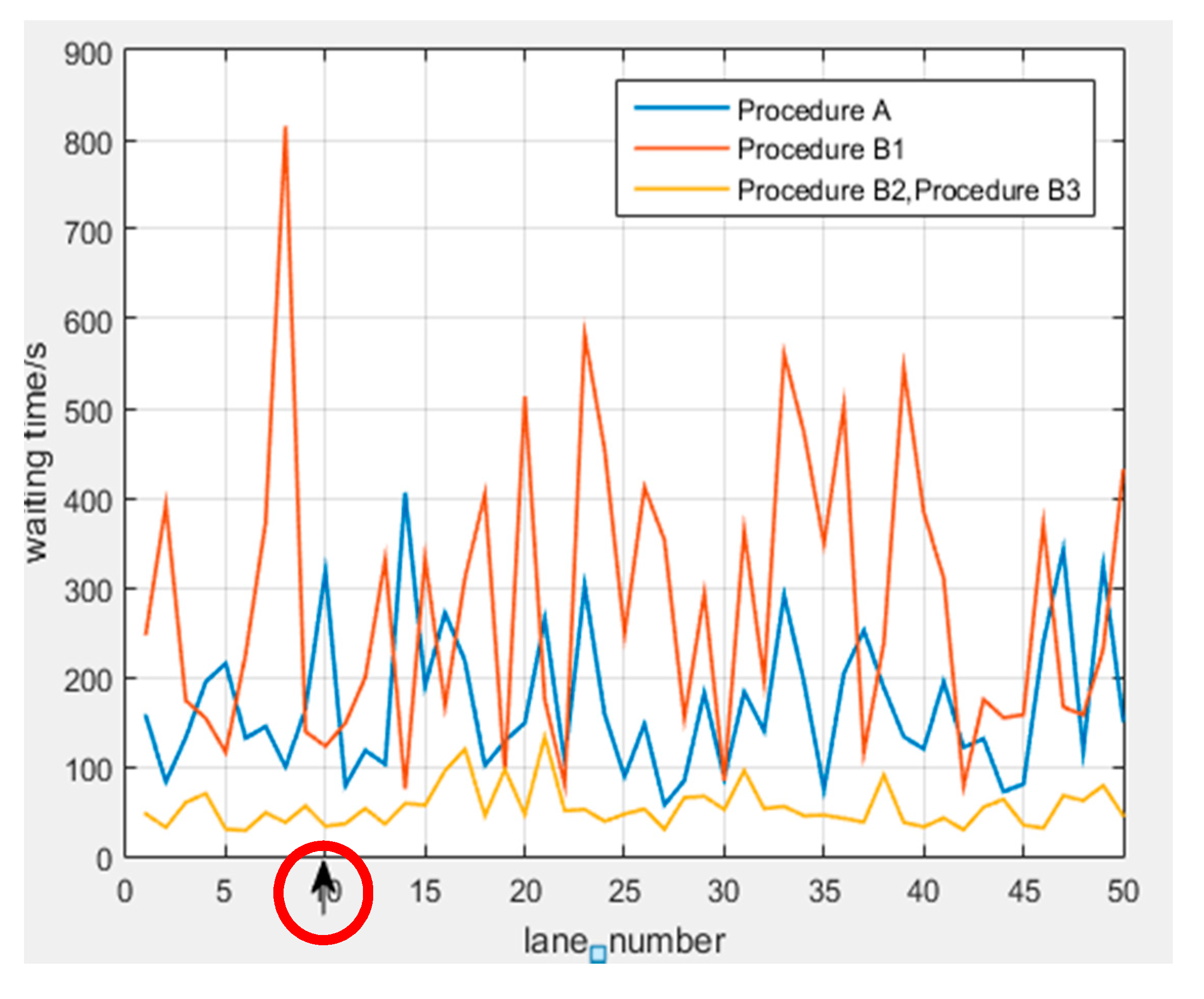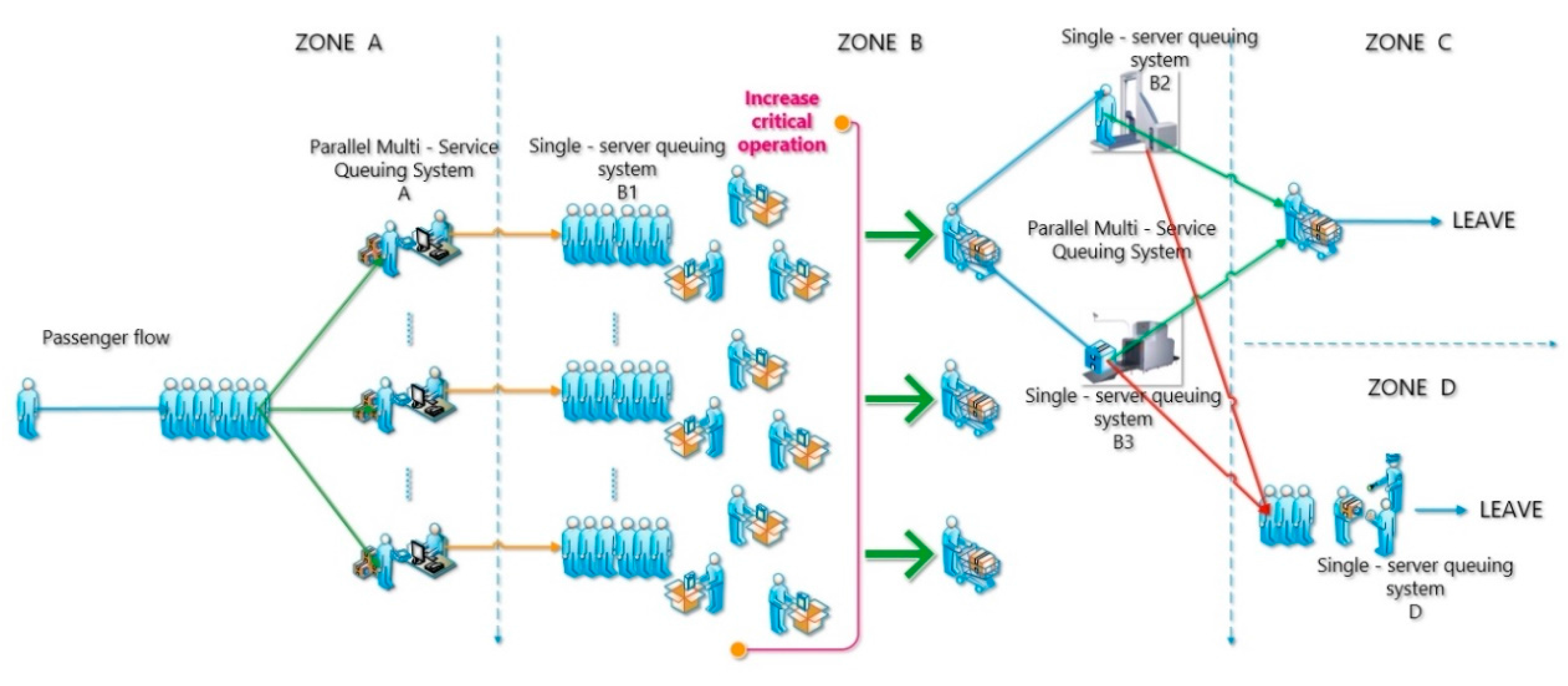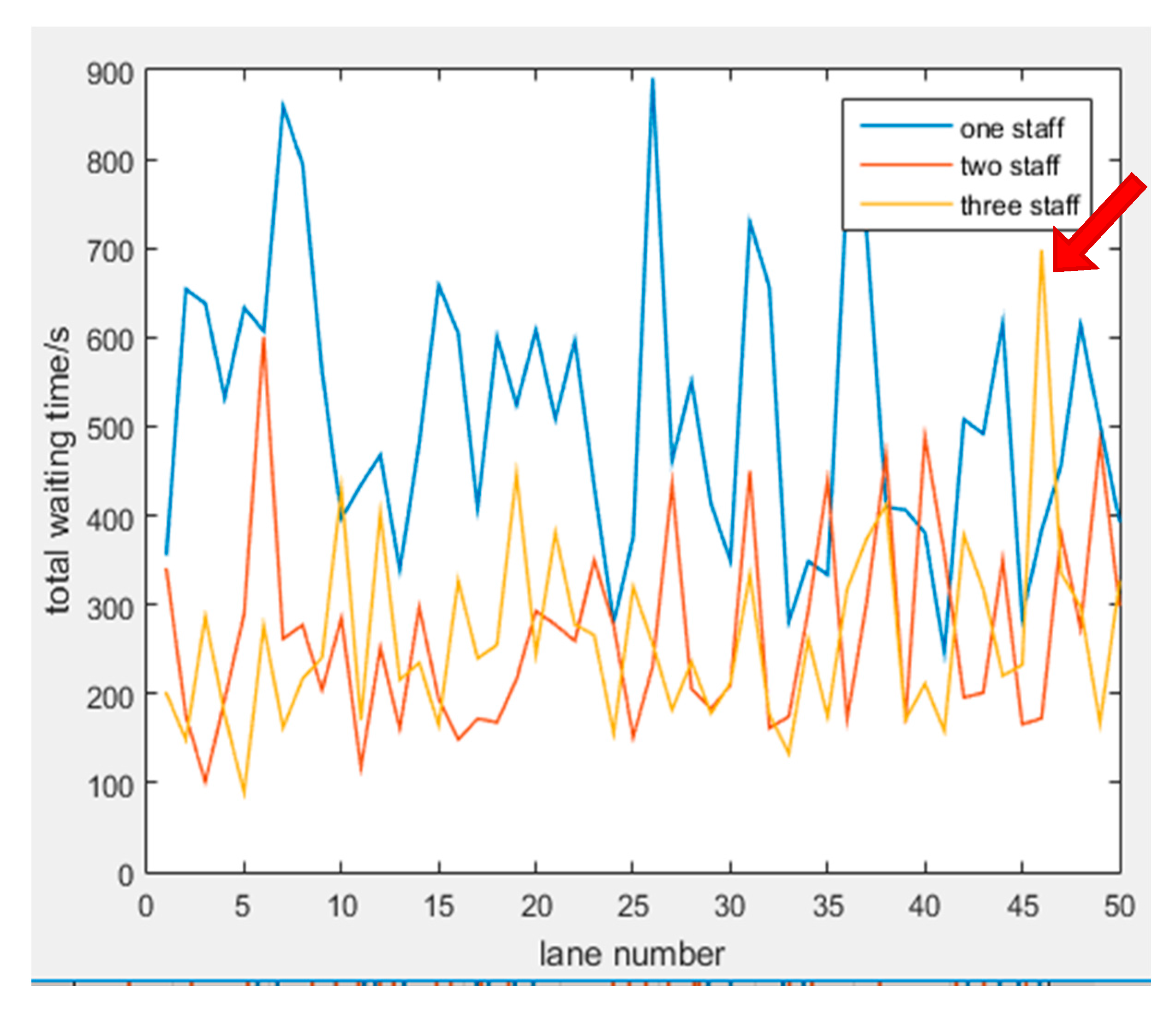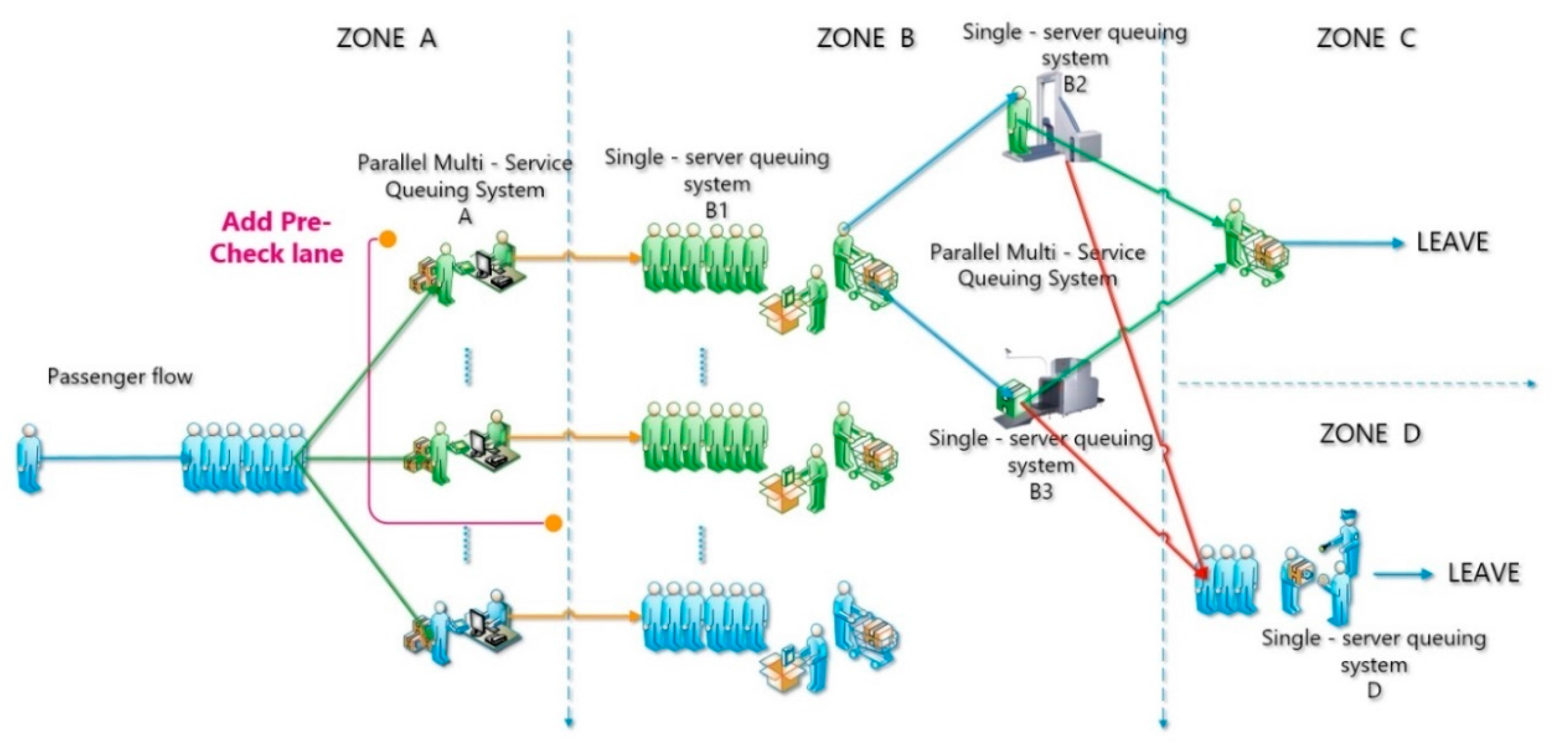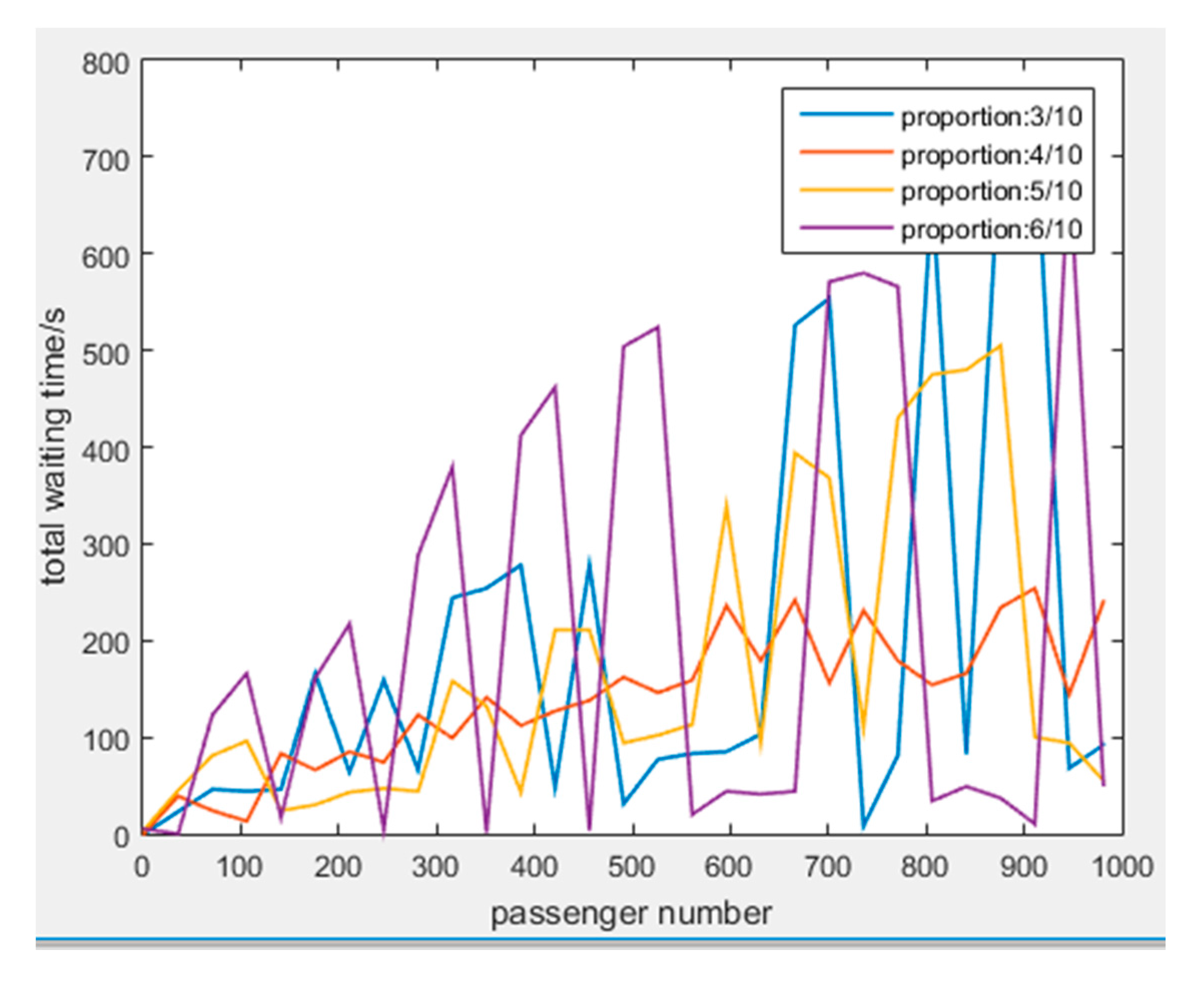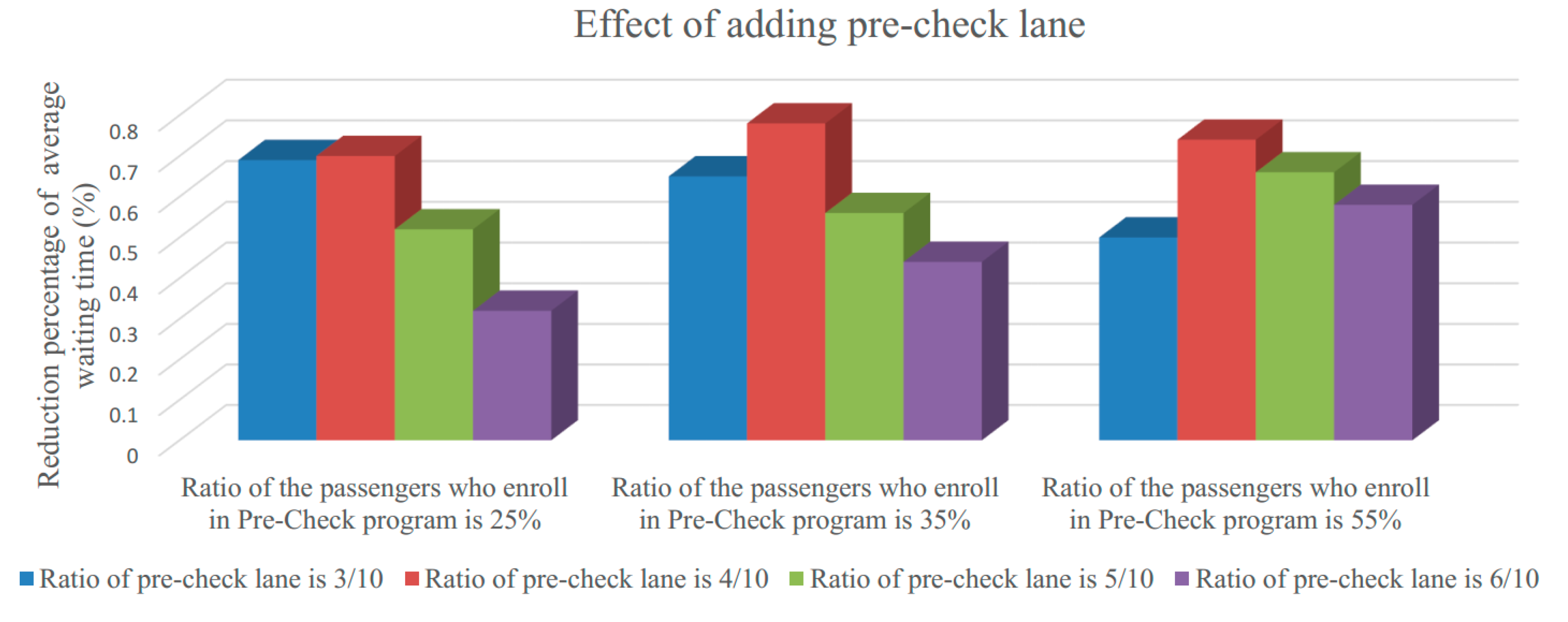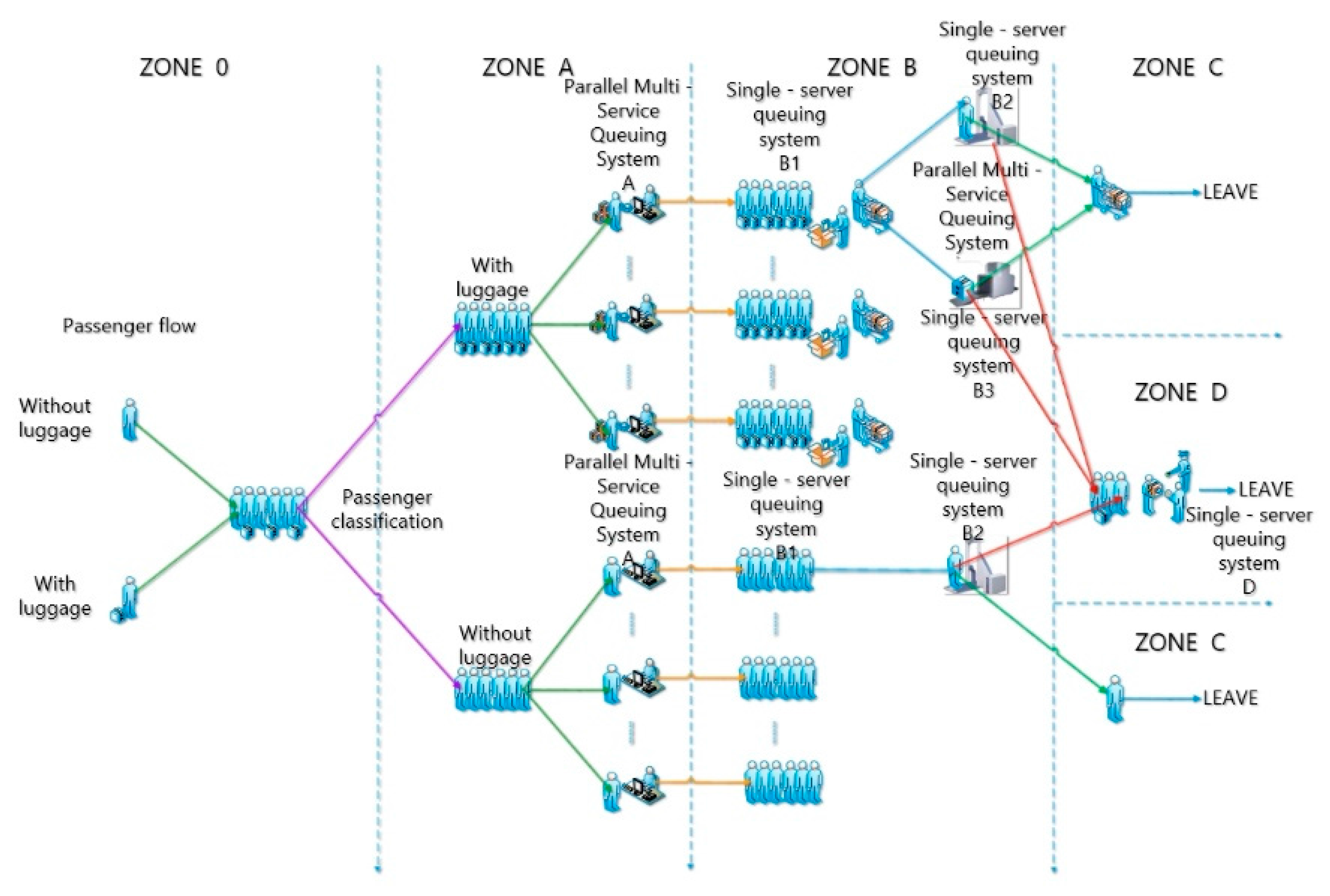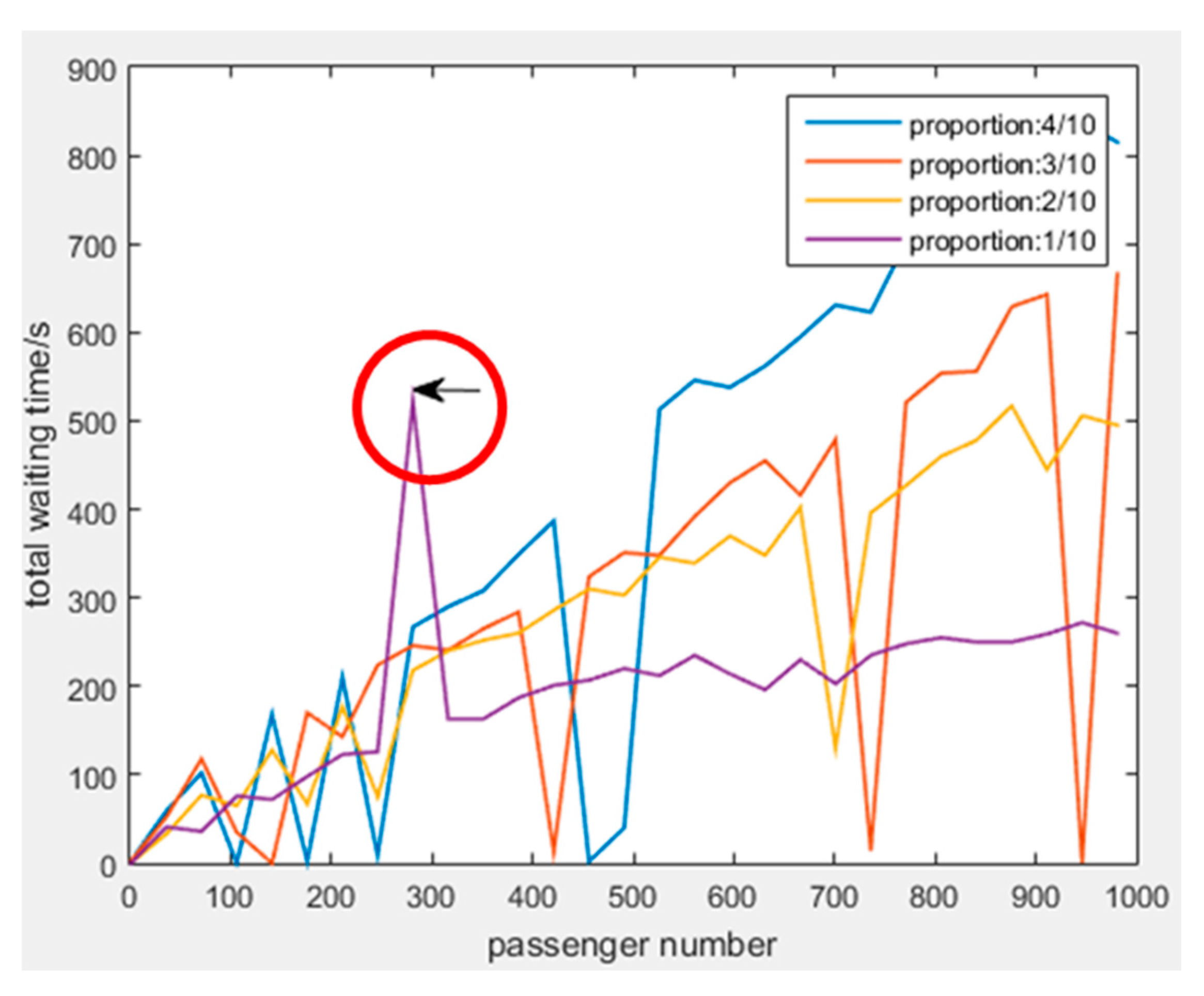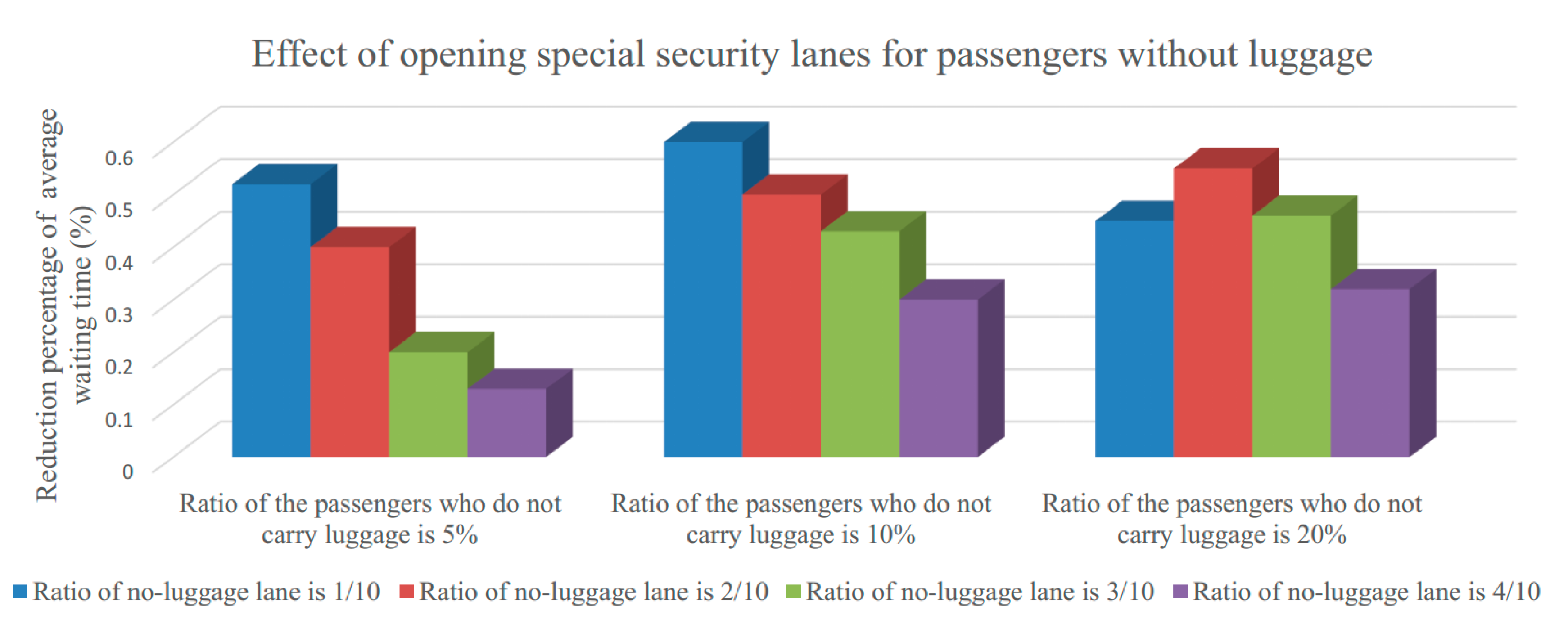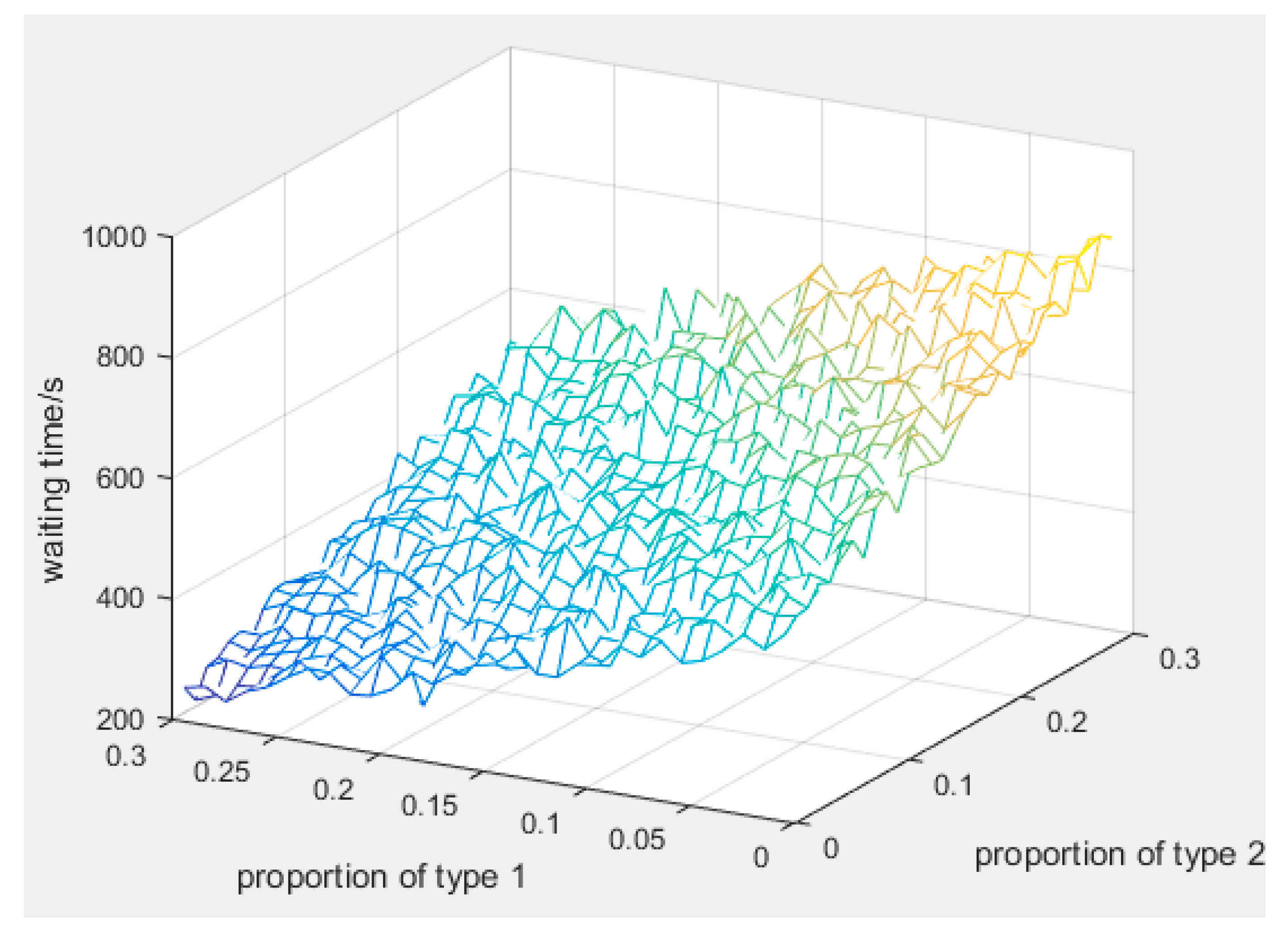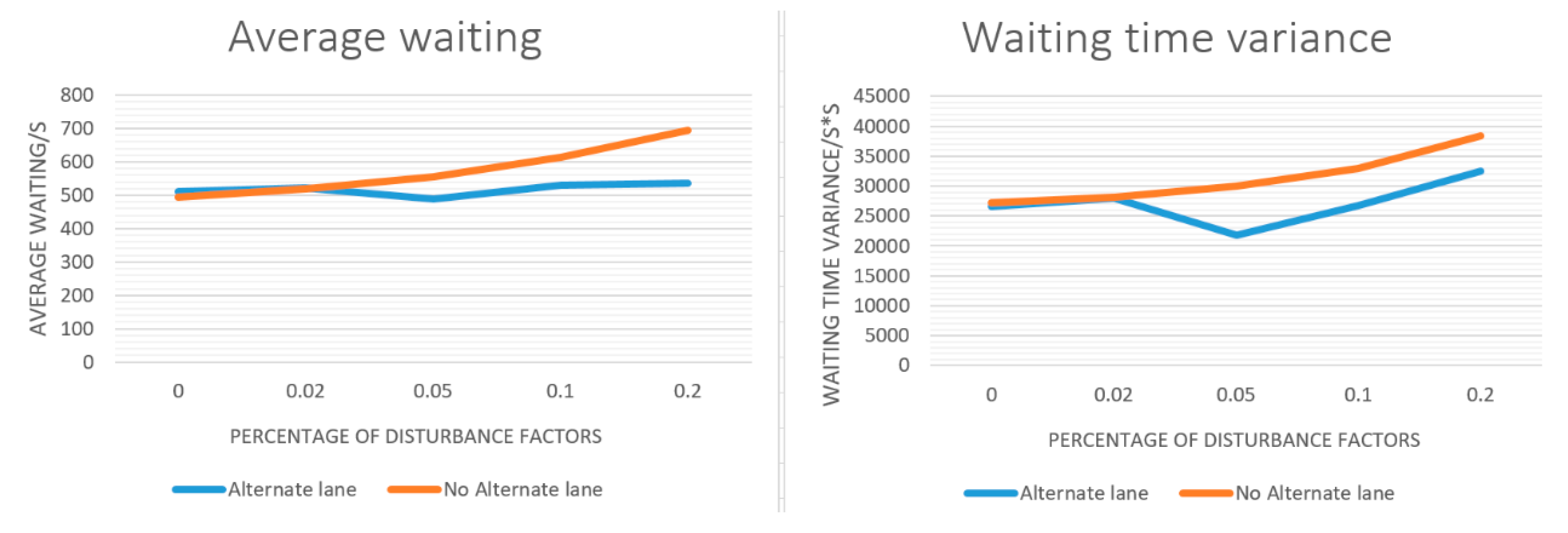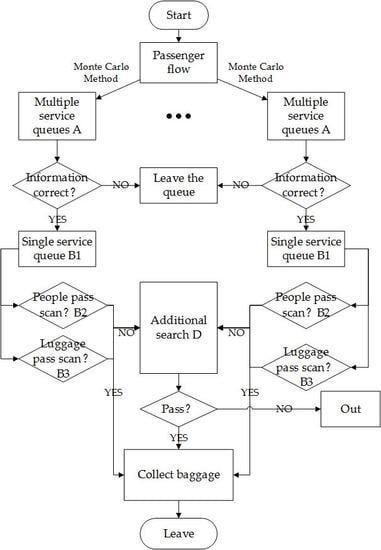1. Introduction
With the rapid growth of the population and economy, the queuing networks of airports and stations are of great importance and require urgent optimization. However, the complex situations in airport security make the process more challenging because of the following: (1) Network chaos, such as congestion due to insufficient network capacity, delays in boarding because of inadequate sequencing, and repeated confusion in security operations; (2) Consequential outcomes, such as incurred higher costs by passengers and businesses, longer waiting time and unfriendly atmosphere of the queuing network, and increased accidents because of unorganized queuing personnel. These problems and contradictions are incompatible with today’s sustainable economy and the concept of sustainable development. Therefore, the motivation of this research is to find sustainable solutions to these aforementioned problems.
As a result, a sustainable queuing network, different from previous networks, is proposed. In general, a sustainable queuing network is less costly, has a better operating procedure, and most importantly, passenger waiting time is shorter and user experience is improved. A sustainable network is beneficial not only for passengers, but also for aircraft and train operators as it is an excellent way to increase their profits. Hence, a research on a sustainable queuing network is significant.
Queuing network was applied in many aspects. Gelenbe and Pujolle [
1] made a study in a general queuing network with its single queue behavior. Perros [
2] discussed Blocking and Feedback with a symmetrical exponential open queue network, and the approximate expression of queue-length probability distribution was mainly considered. Basharin and Tolmachev [
3] applied queuing networks theory to model information-computing systems and defined characteristic properties of computing systems networks. Jun and Perros [
4] proposed a good error-level algorithm for open tandem queuing networks by using an approximate analysis. Tsybakov and Georganas [
5] elevated multi-queue system with finite capacity by deriving the asymptotic optimality of the queue service probability. Gurvich and Whitt [
6] built a diminishing-returns property of flexibility to make the call center as efficient as a single-pool system as the total arrival rate increases.
Recently, there have been many studies on queuing optimization. Federgruen and Groenevelt [
7] made a study on general (single facility) queuing systems with exponential service times, dealing with a finite number of distinct customer classes. Miller [
8] considered the problem of access and service rate control in queuing systems as a general optimization problem for controlled Markov process with finite state space. To minimize the expected cost of the system, Lin and Ke [
9] used the genetic algorithm to find the best thresholds of queue length in activating servers and their corresponding service rate. With the advancement of theoretical research, some new analytical methods have been put forward constantly. Xia [
10] and Cao [
11] established a difference equation of the customer-average performance in closed networks with exponentially distributed service times and state-dependent service rates, which provided a new perspective of performance optimization of queuing systems. Combined with theoretical research, some application examples were analyzed. A method for optimizing and coordinating people queues was proposed by Barajas and Harrington [
12], which further included querying at least one queuing system to determine wait times associated with performing the tasks. Hess [
13] demonstrated application of the queuing theory in modelling a port’s bulk cargo unloading terminal and Zhu [
14] conducted the study on modeling and multi-objective optimization for quick pass system in an amusement park. A new technique was proposed to optimize the functions of fuzzy profit of queuing models by Pardo [
15]. Ya-Qing [
16] developed a physical examination queuing system, effectively shortening waiting time of the subjects and the doctors. There have also been some studies on airport queuing. Parlar [
17] proposed a multi-counter queuing model with a special type of arrival process reflecting reality from the population of passengers booked for the flight and the main feature [
18] was the use of empirical data collected at the Singapore Changi Airport.
Through research, it was found that the modeling and solving of the previous queuing optimization of passengers is more complicated. Therefore, Monte Carlo Method was used in this study to model and solve problems of airport-sustainable networks. Monte Carlo Method is often used in system optimization. Dubi [
19] suggested a methodology that led to a satisfactory and viable solution to the problem in a very general sense with the Monte Carlo Method. Kushner and Yang [
20] developed an effective Monte Carlo Method for obtaining good estimators of systems sensitivities with respect to system parameters. In addition, Monte Carlo method is often cited to form optimization method innovation. Sorella [
21] introduced an appropriate iterative scheme for the minimization of the energy, based on the variational Monte Carlo (VMC) technique. To overcome the biases coming from the assumed variational form of the wave functions, Tahara and Imada [
22] extensively improved variational wave functions with variational Monte Carlo (VMC) Method. Zhu and Li [
23] combined the attractive features of evolutionary algorithm and Markov Chain Monte Carlo into a new Differential Evolutionary Markov Chain Monte Carlo (DE-MCMC) Method for multi-objective optimization problems with continuous variables. Besides, Monte Carlo Method is widely used to solve practical problems. Xu [
24] employed Monte Carlo Method to simulate the queuing behaviors in banks. Beck [
25] presented a method for determining the stationary phase points for multidimensional path integrals employed in the calculation of finite-temperature quantum time correlation functions. Kim [
26] proposed the procedure of obtaining the best illumination for specific patterns by Monte Carlo simulation. Hu [
27] applied the gradient-directed Monte Carlo (GDMC) Method to select optimal members in a discrete space of chemically viable proteins. Hua [
28] solved the transient thermal conduction optimization problem with the Monte Carlo Method and the simulated annealing algorithm. It can be seen that Monte Carlo Method has a very wide range of applications.
The main purpose of this study is to create a sustainable queuing network model based on the Monte Carlo method and analyze the security process of airports. In this model, the average waiting time and variance of the queuing time of passengers are widely recognized as parameters reflecting the performance of the queuing network. In order to efficiently identify the key operation points of the queuing network, the queuing-network theory and Monte Carlo method combined with simulation, are utilized. Through analysis and comparison, it is determined that the main bottleneck in the security process is when passengers wait in line to remove their shoes, belts, jackets, and have other items individually inspected. Finally, three novel solutions are designed to solve these problems and a sensitivity analysis on cultural differences is conducted to facilitate the study and discussion.
The remainder of the paper is structured as follows: the queuing network is described in
Section 2; the development of a sustainable queuing network design model using the Monte Carlo method is presented in
Section 3; the case study for a sustainable queuing-network design and sensitivity analysis are contained in
Section 4; discussions and conclusions of this study are presented in
Section 5.
2. Problem Description
To simplify the model concept figure, we designed a step-by-step security procedure to be a subsystem of the queuing network. Procedure A refers to the verification of the identity information in Zone A. Procedure B1 refers to the inspection process of waiting in line and taking out all the items to be scanned in Zone B1. Procedure B2 refers to the human body microwave scanning in Zone B2. Procedure B3 refers to putting the carry-on luggage through the X-ray machine in Zone B. The marked items in the inspection procedure for further screening are referred to as Procedure D.
A random event stream is the sequence of events that occurs at random moments. If the event flow is smooth, independent, and general, it is called a Poisson event flow (Poisson flow). All modes of transportation utilized by passengers, such as taxies, trains and buses, and all arrival events satisfy the conditions of the Poisson event flow. Therefore, it can be assumed that the arrival time of passengers complies with the Poisson flow rule. Procedure A is the starting point of the whole queuing network, which is a multi-server parallel queuing system. Afterwards, passengers proceed to Zone B for procedure B1, which is a single-server queuing system, and queue according to the original order. Passengers from procedure B1 subsequently continue to procedures B2 and B3. Both procedures B2 and B3 are single-server queuing systems, but these two steps are simultaneous; a parallel system. Process D is a special situation and will not be considered in the initial setup of the model.
Through concept mapping of the model, the process can be intuitively understood.
Based on the queuing network system shown in
Figure 1, the Monte Carlo method is used to perform a series of simulations, such as searching for key operating points to locate bottlenecks in the security process, optimizing the queuing system structure to optimize the overall queuing efficiency, and reducing the queuing time and time variance.
3. Sustainable Queue-Network Model Based on Monte Carlo Method
3.1. Model Framework
The Monte Carlo method is a stochastic simulation method, which is based on the probabilistic and mathematical statistical theory method. It is a method for solving many computational problems by using random numbers (or known as pseudo-random numbers). The problem to be solved with a certain probability model is associated with computer technology in order to achieve statistical simulation or sampling and obtain the approximate solution. To solve the problem, the model framework is developed.
The security procedure in the queuing process shown in
Figure 2 is based on the typical security process and security requirements. To elaborate on the problem, the above process is decomposed. In the figure, there are five queuing system models, which are interlinked to form a queuing network through passenger flow. The five queuing systems are as follows: (1) Queuing system A: In Zone A, passengers randomly arrive at the checkpoint and wait in queue until their IDs and boarding documents are checked by security personnel; (2) Queuing system B1: In Zone B1, passengers prepare all of their belongings for X-ray screening. Passengers must remove items, such as shoes, belts, jackets, metal objects, electronics, and containers with liquids, and place them in a bin to be X-rayed separately; laptops and some medical equipment also need to be removed from their bags and placed in a separate bin; (3) Queuing system B2: In Zone B2, passengers go through either a millimeter wave scanner or a metal detector; (4) Queuing system B3: In Zone B3, all passenger items, including luggage, are placed on a moving conveyor and checked by an X-ray machine; (5) Queuing system D: In Zone D, if passengers or their carry-on baggage fail in the security check, additional search or screening is conducted.
3.2. Queuing Network Modeling on Monte Carlo Method
The queuing system has the following three basic components: input part, queuing rules, and service organization. It is assumed that the arrival time of different passengers is random, the time spent by each security process is stationary, and the expected value and variance of the distribution are stable. In the input process, the passenger arrival flow basically satisfies smoothness, and no rear-effect and universality. Thus, it is presumed that passenger arrival is a Poisson flow, which satisfies single arrival, infinite source, and independency from each other. The queuing rules include the waiting and first-come-first-checked rules. The system capacity is enormous to the extent that it can be approximated as infinite. Under service rules, passengers are individually screened, the security window is a parallel window, and the service time has no memory and obeys a negative exponential distribution, and the service time of each security window is independent. According to the process of airport security check and the basic model parameters of the queuing theory, the five queuing systems mentioned above are standardized.
(1) Queuing System A is a multi-service queuing system. Suppose that the parameter of the arrival of passengers as a Poisson flow is , the service lane for verifying identity is independent, the average service rate is , and the number of multi-service stations is . According to the standard M/M/c, it is found that:
System A service intensity:
The probability that the system A is idle:
where
k is a natural number from 0 to
c − 1.
The average number of passengers in the queue A:
where
n is the total number of passengers in the system A.
Average waiting time for passengers in the queue A:
(2) Queuing System B1 is a single-service queuing system. The passenger flow comes from passengers passing through Zone A, and only passengers passing through Zone B1 can pass through Zones B2 and B3. Therefore, passengers passing through Zone A are assigned to respective service queues. Initially, assuming that the passenger queue is short, then, Zone B1 of the queuing system has the same single-service queuing system. The service time of Zone A obeys a negative exponential distribution, and so the passenger arrival flow of Zone B1 is still a Poisson flow obeying the parameter . Suppose the average service rate is and one of the queuing systems is taken as the research object. According to the standard M/M/1 model, it can be learned that:
System B1 service intensity:
The probability that the system B1 is idle:
The average number of passengers in the queue B1:
Average waiting time for passengers in the queue B1:
According to the relations of the passenger arrival flow in Zone B1 and the passenger flow going through Zone A, it can be learned:
(3) Queuing System B2 is a single-service queuing system. In Zone B2, the passenger flow comes from the corresponding zone, B1. The service time of Zone B1 obeys the negative exponential distribution. Thus, the passenger arrival flow at Zone B2 remains a Poisson flow, which obeys the parameter . Suppose the average service rate is . Then, according to the standard M/M/1 model, it can be learned that:
System B2 service intensity:
The probability that the system B2 is idle:
The average number of passengers in the queue B2:
Average waiting time for passengers in the queue B2:
According to the relations of the passenger arrival flow in Zone B2 and the passenger flow going through Zone B1, it can be learned:
(4) Queuing System B3 is a single-service queuing system. In Zone B3, the baggage flow comes from the corresponding zone, B1. The service time of Zone B1 follows the negative exponential distribution and therefore, the baggage arrival flow at Zone B2 continues as a Poisson flow obeying the parameter . Suppose the average service rate is . Then, according to the standard M/M/1 model, it can be learned that:
System B3 service intensity:
The probability that the system B3 is idle:
The average number of passengers in the queue B3:
Average waiting time for passengers in the queue B3:
According to the relations of the baggage arrival flow in Zone B3 and the passenger flow going through Zone B1, it can be learned:
(5) Queuing system D is a single-service queuing system. In Zone D, the passengers are those who do not pass through Zone B2 or whose bags do not pass through Zone B3. Consequently, the passenger arrival at Zone D is a random event with a low probability. For the entire security process, Zone D performs a small function, and therefore, the security congestions can be formed in the whole process beyond Zone D.
3.3. Airport Security Simulation on Monte Carlo Method
According to the Poisson distribution in probability theory, it can be learned:
P(
N(
t) =
n) is the probability of reaching
n passengers in
t hour.
E(
Nt) is the expectation to reach the
N passengers in
t hours. The Poisson process has a steady increment and satisfies:
Let
λ be the rate or intensity of the process, which is the average number of events per unit time. According to the knowledge of probability theory and mathematical statistics, the passenger arriving time interval obeying negative exponential distribution with parameter
λ:
Using the Monte Carlo method, a pseudorandom number, , is generated by a computer program and the time interval, t, is calculated according to the above formula. Simulate the negative exponential distribution of the service process, and generate a Poisson flow for the input process.
The airport security simulation process using the Monte Carlo method is as follows: (1) Data in the table are processed to obtain the average waiting time, that is, the average service rate, , of the service station; (2) The generated pseudo-random number is used to generate the passenger arrival time. The service time of the four queuing systems through Zones A, B1, B2, and B3 are then generated by the pseudo-random number; (3) The queuing rules for passengers based on the first-come-first-checked rule are developed. Moreover, passengers can only wait until the security check-in lane is available. Obviously, default passengers automatically select the lane with the shortest queue. After the passenger enters a queue, their choice can no longer be changed. Because passengers need to pass through together with their luggage, these passengers spend longer waiting times at Zones B2 and B3; (4) By automatically generating the arrival time of passengers, the whole process of airport security, the average waiting time, and queue length of the four queuing systems are simulated; (5) The whole process of the airport security inspection is simulated several times, and the average of the indicators is selected to minimize the impact of random errors.
5. Conclusions
Through the examination and modeling of airport security issues, the following conclusions are reached: (1) The airport-security queuing system belongs to a Monte Carlo Method-applicable network systems, in which several steps have serial and parallel relationships. When the entire network queuing system is operating, the longest-running process is called key operation. The solution to the problems encountered under key operation can effectively improve the airport passenger security throughput and airport operating efficiency; (2) Through simulation, it is found that the longest process in the entire security process is the process of waiting for passengers to line up, remove their shoes, belts, and jackets, as well as bring out items that need to be scanned. Because the process usually takes about 250 s per passenger, passenger flow is immobilized. This process is considered the key operation of the security network queuing system; (3) By analyzing the O’Hare airport security process data, it is evident that the queuing times of passengers vary. After the actual situation analysis, this variation may be because the number of passengers who carry luggage significantly differ from and approximately half of the passengers are registered in the pre-check program. Nevertheless, this part of the passenger security process needs to be swift and simplified; (4) Cultural differences may have a significant impact on the choice of airport security. Every passenger who goes through the airport security process needs to be satisfied to a certain extent. The higher the degree of satisfaction is, the smoother and quicker the security process becomes. However, as the degree of satisfaction gets lower, the process becomes less smooth and slower, which may cause some security problems and add more time to the entire security process.
In this paper, the queuing-network model based on the Monte Carlo method is used to model and analyze the airport security process. Based on the average waiting time of passengers and the use of the aforementioned model and method, the main holdup in the security process occurs when passengers line up to remove their clothing accessories and take out items from their luggage. Accordingly, based on the conclusions drawn from the model analysis and existing security programs in the airport, the structure and function of the model are optimized. Three novel solutions are designed to solve the identified problems so that the average waiting time spent through the airport security process is reduced by 51.1–72.9%, and the variance of passenger queuing time is effectively reduced by 33.2–82.4%. It is evident that the solutions are good and can benefit airport staff and passengers. Furthermore, a sensitivity analysis on cultural differences is conducted to facilitate the study and discussion. Through a sustainable queuing-network design for the airport security process based on the Monte Carlo method, the model fully considers applicability and fault tolerance. It also has high authenticity, being closely related to the problem and actual situation. Nevertheless, this research has a few limitations. The cost of operating the entire airport security process and the intensity of the work are not considered in this model. In future studies, the effects of various airport service rules will be considered. Furthermore, the combination of multiple optimization schemes will be examined in order to identify the best system design for security efficiency and cost.
